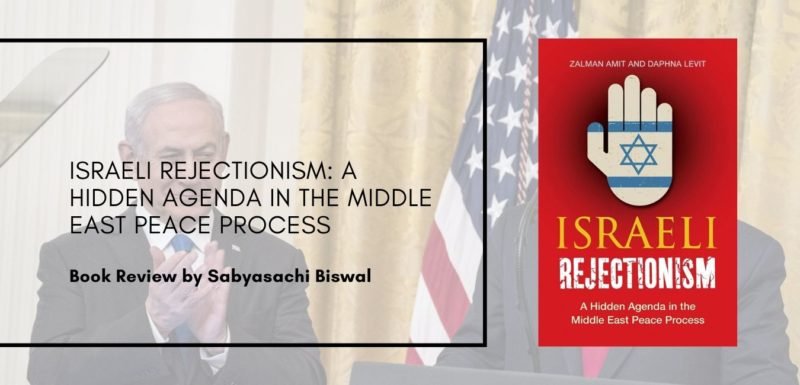Israeli Rejectionism: A Hidden Agenda in the Middle East Peace Process | Book Review

“Our position is that Israel was never primarily interested in establishing peace with its neighbours unless such peace was totally on its own terms” (Pg. 11). This particular statement might come off as a genuine surprise for those who are involved in the pedagogical discourse of the conflict in Israel and the Middle East. In fact, it is no less than a shock for someone who is even passively interested in the said pedagogy and has formed an initial perception that in the entire tussle between Israel and the Arab World, or Israel and Palestine, it is always the righteous state of Israel who has had the moral high ground in putting a halt to the said conflict.
The idea of Israel being the harbinger of peace in the Middle East has been a Western constructed narrative, peddled to the world community by elites of Israel at their political and military convenience to sustain their deceitful activities of near-colonial, hawkish expansion in the Middle East, after half a century of victimized blaming on the moderately peace-loving Arab nations. However, as much as the audience will blame the author of this review for a biased perception sans credible evidence, these are the words elucidated by author duo Zalman Amit and Daphna Levit in their controversial book.
Albeit courageous and bashful in its narrative, the author duo’s book gives its readers a bland truth garnished with indigestible information, which some might call out as a loathing grudge against Israel. But nonetheless, as the authors suggest, this book has been written with precise historical accuracy, collected over millions of documents preserved in the ancient, muted libraries of Israel, narrating the Palestine’s side of the story in what we call now as one of the largest running, protracted confrontations of the modern world, after World War II.
Maybe this is exactly why the author duo gather enough courage to call this book a position paper and not a historical manifestation (Pg. 11), trying their fullest to bring forward the ruthless Israel which was kept hidden from the world for too long. Daring to articulate truth kept silent for too long by all mainstream reputable opinion-makers, Amit and Levit’s book acts a counter-argument to all its contemporaries who, inspired by the long structured Western narrative end up writing in favour of Israeli atrocities on Palestine as a facet of its national survival and Jewish-Biblical culture.

Amit and Levit build a strong case, well-founded on fundamental argument by using a chronological narrative of events right from the Basel Congress of 1897 to Second Lebanon War in 2006. To be true to oneself, this chronological narrative makes the book an easier piece of research, building suspense on Israel’s movement over the years, from deceitfully ignoring peace to electing leaders who can prolong negotiations to deny peace, compiled under the mandate of forceful Israeli expansion in Palestine to strip the Palestinians of their resources, and rightful home.
As the authors point out, right from the founder of Zionist movement Herzl to Ariel Sharon, every single Israeli leader has had the idea of complete domination of Palestinian territories through messianic expansion and using the leverage of Holocaust on Jews during World War II as a card of great victimization. This later became an informal state policy to garner the support of Israeli citizens to remain in power and carry out atrocities in the name of fear and freedom. In fact, a new-found Zionist state from 1948 even followed the precedence set by Ben Gurion, who very hypocritically rallied in his public or political speeches that Israeli as a weak new-born state has to talk peace in the international forum but take land in reality in order to survive. There has been no change in the status quo until now. Even the leaders who decide to take a moderate stance towards the Arabs were either forced out of the Knesset or forced into accepting this frivolous, and informal state policy.
It is to be taken into due consideration that the author duo being Jewish were staunch pro-Zionists, and in their early years have promised their life to IDF and the idea of Kibbutz after 1948 and 1956 Arab-Israeli War. This particular information not only gives an innate sense of credibility to the Anti-Israeli information laid out by them in the book but also makes the book far more controversial in the Jewish community, leading to a scarce acknowledgement of a very well exemplified fact-sheet in the literary world.
Moving further ahead with the book, the readers will not fail to notice that the structure of the book has been divided by a certain year which has not been well specified with important markers and can be easily missed. The year in question is 1984 which the author mentions as a period where Arab-Israeli confrontation explicitly turns into active Israel-Palestine conflict followed by a similar pseudo-democratic, extreme right-wing stance leading to a war-like possession of a biblical land from the rightful Palestinians, through messianic expansion.
This paved the way for the clash between Israel and the Islamic Jihad, Hamas, and Fatah. This clash has not prejudiced among innocent Palestinian women and children and has subjected them to harsh treatment by the Israeli ruling elites which can be drawn as a parallel to Western colonialism and slavery in the 19th century.
The book “Israeli Rejectionism” as the authors suggest is an honest attempt to mention the myriad of injustices prevailing in the Israeli system since “an equitable peace settlement in the Middle East was never Israel’s top priority” (Pg. 163). Deceit, hypocrisy, military extermination, ethnic cleansing, unnecessary provocation, wrongful opportunity as the authors describe are some of the tools used by Israel to acquire expansion at the behest of innocent blood.
This makes them to believe that the conflict was a result of terrible wrongs where Israel as an unnecessary victim has self-created, perpetuated and cynically exploited much of its inconvenience to garner worldwide attention and alliance (Pg. 163). This will lead one to believe and in fact understand this book as a red marker on Israeli politics, and a path to reach the root of all its injustices, not only perceive it.
Fluidic, informative, well researched, and bitterly truthful are some of the words that can be used to describe the intentions and structure of this book, which also plays out as its strength. With facts inclined towards the plight of the Arab world and Palestine rather than the general Israeli notion in looking for a viable option for peace in the Middle East, this book is a must recommended for researchers trying to understand the current conflict as well as trying to gain insight on militant pursuits in a democratic state. The fluidic, chronological style of explanation also makes it a handy text for students as well as casual readers interested in International Relations to gain credible knowledge on the situation at hand lest they want to be shadowed by bias.
In fact, bashful bias towards the role of Israel in the conflict is a major weakness of this book, since it puts the entire onus of blame for the escalation of conflict in the Middle East on Israel without considering the provocation, and un-sound judgement of Western and Israeli peace treatises on the Arab side. It also tries to paint Israel in a picture of Goliath, equipped with modern military arms exploiting the relatively unarmed Palestinians by driving them from their rightful territory. This information no matter how relevant fails to make sense after the first Intifada at least and might be perceived as a lie by general readers. Not taking Israeli struggle and casualties into account can give Israel an unmistakable picture of veritable, hegemonistic Juggernaut in the region which in the long run can lead to a burden of doubt shifting towards the meek image of Palestine as the only desecrated victim causing problems in the discourse of the said pedagogy. These biases can also tip off the balance of the conflict in the academics leading to information asymmetry. So, it is advised that even if one engrosses himself/herself in the well-elucidated facts of the book, it is better to keep the mind open for more perceptions and at the end decide on your own as to which side deserves the world’s and ultimately the reader’s sympathy.
In the end, the book only raises further research concern in comparison and judgement of perceptions laid out to that of the ever-present, and generally sold Western narrative as it single-handedly balances the narrative towards Palestine in the literary world for the greater good. But this book should not be treated anything more than the different sides of the same biased coin as it works no more than clearing the image of Palestine as the victim in the conflict and is far from being moderately balanced for the benefit of academics. Availability of this book on a much wider spectrum as it is now will offer a stronger contribution to literature and academics alike as it will not only broaden the horizon of perceptions on the conflict but will describe with more intensity and facts on what we can rightfully call a conflict of grave misinterpreted errors and wrong-doings for selfish interests.
Book Details: [Zalman Amit and Daphna Levit; Series I; London-New York; Pluto Press; 29th July 2011, Pg. 208; (Paperback); ISBN 978-0-7453-3028-0]


















